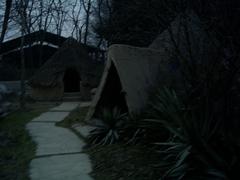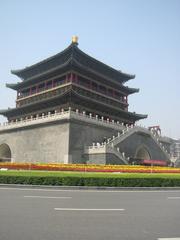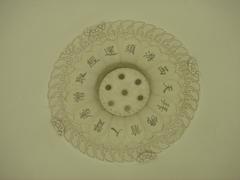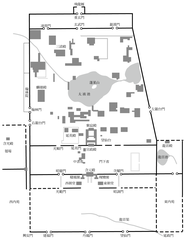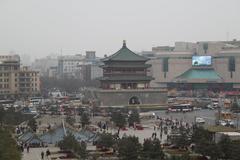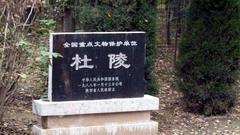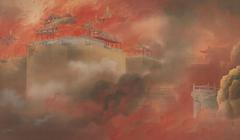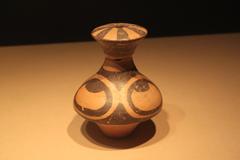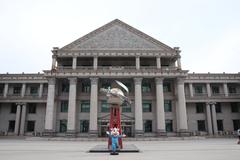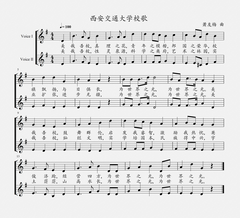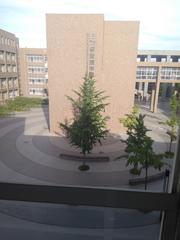East Mausoleum of Qin: Visiting Hours, Tickets & Xi’an Historical Sites Guide
Date: 04/07/2025
Introduction
The East Mausoleum of Qin, also known as the Mausoleum of the First Qin Emperor (Qin Shi Huang), is one of China’s most significant archaeological sites and a highlight of Xi’an’s historical landscape. Located in Shaanxi Province near Xi’an, this vast complex offers a window into the grandeur of ancient Chinese civilization, reflecting the unification of China under the Qin dynasty and the emperor’s quest for immortality. With its monumental scale, intricate burial grounds, and the world-renowned Terracotta Army, the mausoleum is both a symbol of imperial ambition and a testament to extraordinary craftsmanship (Berkshire Publishing; Britannica).
This guide provides a comprehensive overview of the mausoleum’s history, cultural significance, archaeological discoveries, practical visitor information, preservation efforts, and nearby attractions, serving as the essential resource for anyone planning to visit or seeking to understand this UNESCO World Heritage Site (UNESCO).
Table of Contents
- Introduction
- Historical Background & Archaeological Significance
- Visiting the East Mausoleum of Qin
- Site Layout & Main Attractions
- Preservation Efforts
- Visitor Experience
- FAQ
- Conclusion & Recommendations
- Sources
Historical Background & Archaeological Significance
The Reign of Qin Shi Huang and the Birth of the Mausoleum
Qin Shi Huang (259–210 BCE), the first emperor to unify China, began constructing his mausoleum at just 13 years old. The project, which lasted nearly 38 years, involved approximately 700,000 workers and was intended as an eternal palace reflecting his power and the unified empire (Berkshire Publishing; HeritageDaily).
Architectural Layout & Symbolism
The mausoleum covers over 50 square kilometers and mirrors the urban plan of the Qin capital, Xianyang, with concentric walls and a central mound designed to resemble a wooded mountain. Ancient accounts describe the tomb as containing a map of China made from mercury, with rivers and seas flowing through a subterranean palace, symbolizing imperial dominion (Britannica).
The Terracotta Army: Guardians of the Afterlife
Discovered in 1974, the Terracotta Army is the mausoleum’s most famous feature. The life-sized clay warriors, horses, and chariots—each with unique facial features and armor—were created to protect the emperor in the afterlife and symbolize the might and diversity of Qin’s unified army (Traveling in China; HeritageDaily). The army is divided into three main pits, each representing different military units and formations (Travel China Guide).
Archaeological Discoveries & Preservation Challenges
Beyond the Terracotta Army, excavations have revealed bronze chariots, weaponry, stables, and exotic animal remains. The central tomb remains unopened due to high mercury levels and concerns about preservation and safety (HeritageDaily; futura-sciences.com). Conservation efforts focus on stabilizing the fragile pigments that once adorned the warriors and protecting the site from environmental and human threats (Xinhua News).
Visiting the East Mausoleum of Qin
Location & Access
The mausoleum is situated at the northern foot of Mount Li in Lintong District, about 35–40 km northeast of Xi’an city center (Travel China Guide). It is easily reached by taxi, public bus, or organized tour.
Visiting Hours
- March 16 – November 15: 08:30–18:30 (last admission 17:00)
- November 16 – March 15: 08:30–18:00 (last admission 16:30)
Note: Hours may vary during holidays and special events. Check the official website for current information.
Ticket Prices
- Adults: 150 RMB
- Students/Seniors: 75 RMB (with valid ID)
- Children under 1.2m: Free
- Combined tickets: Available for access to multiple pits and exhibitions
Advance booking is recommended, especially during peak seasons. Tickets may be purchased online or at the entrance. International visitors can use third-party platforms if needed.
Accessibility & Guided Tours
- The site is wheelchair accessible and offers facilities for visitors with disabilities.
- Guided tours are available in multiple languages and are highly recommended for deeper insights.
- Audio guides and volunteer consulting services are also available.
Nearby Attractions
- Mount Li Scenic Area: Known for its natural beauty and historical significance.
- Xi’an City Wall: The best-preserved ancient city wall in China.
- Shaanxi History Museum: A treasure trove of ancient Chinese artifacts.
Site Layout & Main Attractions
Terracotta Army Pits
- Pit 1: The largest, with over 6,000 warriors and horses in battle formation.
- Pit 2: Features cavalry, archers, and chariots; ongoing excavations are visible.
- Pit 3: The smallest, thought to be the command center.
Museum Exhibition Halls
Exhibits include bronze chariots, weapons, and other relics unearthed from the site. Special exhibitions and temporary displays are hosted regularly.
The Unopened Tomb
The central burial mound rises 76 meters and remains sealed, believed to be protected by mercury and ancient traps (iflscience.com). Non-invasive technologies like muon tomography are being explored to survey the tomb’s interior.
Satellite Tombs & Ritual Sites
The surrounding necropolis contains hundreds of satellite tombs for royal family members, officials, and artisans, as well as ritual sites reflecting the religious practices of the Qin dynasty.
Preservation Efforts
Legal Protection & Site Management
The mausoleum is protected under China’s Law on the Protection of Cultural Relics and is a State Priority Protected Site. Site management is overseen by the Shaanxi provincial government and the Qinshihuang Mausoleum Museum, with strict conservation regulations in place (UNESCO).
Conservation & Restoration
Specialized laboratories work to conserve the painted layers on the Terracotta Warriors and other artifacts, using advanced technologies to stabilize and restore relics (Xinhua News; Global Times).
Sustainable Excavation
Much of the site remains unexcavated to prevent damage. Future work depends on advances in preservation technology (Visit Terracotta Warriors).
Community Engagement & International Collaboration
Education programs, multilingual tours, and international research partnerships help promote stewardship, responsible tourism, and the sharing of conservation expertise (Travel China With Me; Global Times).
Visitor Experience
Transportation
- Taxi/Didi: 1 hour from Xi’an city center, approximately 90–100 RMB.
- Public Bus: Bus 306, 914, or 915 from Xi’an Railway Station; around 1.5 hours.
- Organized Tour: Convenient for seamless access and interpretation.
Onsite Facilities
- Restrooms at the entrance and near main pits.
- Food and drink vendors near the entrance; bottled water is advisable.
- Souvenir shops selling replicas and local crafts.
- Wheelchair-accessible paths connect main exhibition halls.
Visitor Conduct & Photography
- Photography is allowed, but flash is forbidden to protect artifacts.
- Visitors must not touch exhibits or cross barriers.
- Follow staff and guide instructions for preservation and safety.
Tips for Visiting
- Best times: Early morning or late afternoon on weekdays, especially in spring or autumn.
- What to bring: Water, sunscreen, comfortable shoes, and weather-appropriate clothing.
- Crowds: Arrive early, particularly during holidays.
- Booking: Reserve tickets in advance whenever possible.
- Language: English is spoken by official guides; signage is limited.
Frequently Asked Questions (FAQ)
Q: What are the visiting hours?
A: 8:30–18:30 (March 16–November 15), 8:30–18:00 (November 16–March 15). Check the official website for holiday variations.
Q: How do I buy tickets?
A: Online via official or third-party platforms or at the entrance. Advance purchase is strongly advised in peak periods.
Q: Are guided tours available?
A: Yes, in multiple languages. Audio guides and volunteer consultants are also available.
Q: Is the site accessible for wheelchair users?
A: Yes, with accessible paths and facilities.
Q: Can I visit the main tomb?
A: No, the central burial mound remains unopened for preservation and safety reasons.
Conclusion & Recommendations
The East Mausoleum of Qin offers an unparalleled journey into China’s imperial past. Its breathtaking Terracotta Army, enigmatic tomb, and sophisticated ancient engineering captivate millions of visitors each year. To maximize your experience, plan ahead: secure tickets in advance, select optimal visiting times, consider guided tours, and respect all conservation guidelines. Nearby attractions such as the Xi’an City Wall and Shaanxi History Museum offer further cultural enrichment. Leverage official resources, mobile apps like Audiala, and virtual tours for up-to-date information and enhanced exploration.
For additional travel tips, preservation updates, and exclusive multimedia content, download the Audiala app and follow our social media channels.
Sources
- Mausoleum of the First Emperor of Qin Dynasty, Berkshire Publishing
- Qin Tomb, Encyclopaedia Britannica
- New Terracotta Discovery at First Emperor’s Mausoleum, HeritageDaily
- New Evidence May Reveal the Source of Mercury in the Tomb of the First Emperor, HeritageDaily
- Emperor Qinshihuang’s Mausoleum Site Museum, Traveling in China
- Why Archaeologists Are Too Scared to Open the Tomb of China’s First Emperor, iflscience
- The Terrifying Reason Archaeologists Will Never Open the Tomb of China’s First Emperor, medianewsc.com
- The Layout of Emperor Qin Shi Huang Tomb, terracottaarmychina.com
- Terracotta Army, China Highlights
- This Tomb Is a Deadly Trap: Archaeologists Still Refuse to Open It, futura-sciences.com
- East Mausoleum of Qin, UNESCO World Heritage
- Qin Shi Huang Mausoleum, Travel China With Me
- Preservation Efforts for the Terracotta Warriors, Visit Terracotta Warriors
- Source of Mercury in Mausoleum of First Emperor, Archaeology Mag
- Shaanxi History Museum and Xi’an City Wall, Travel China Guide
- Terracotta Warriors Preservation News, Xinhua News
- Conservation and Research Collaboration, Global Times
- Xi’an Deep Tour
